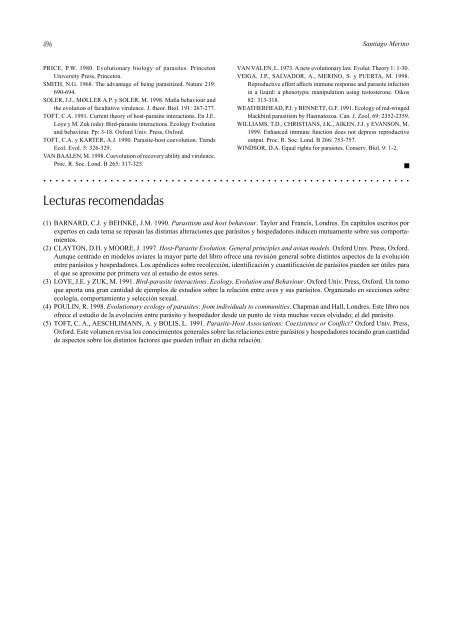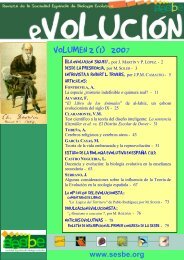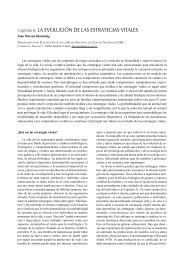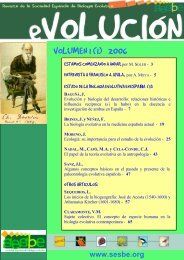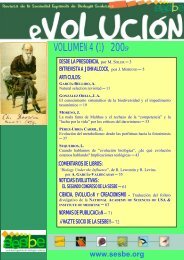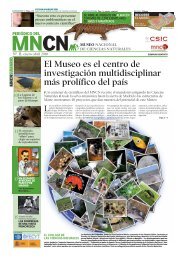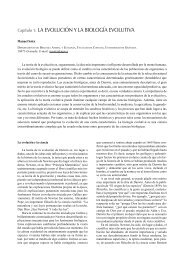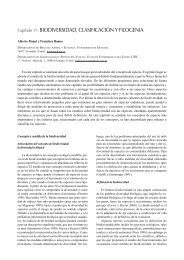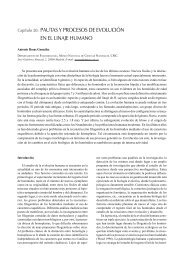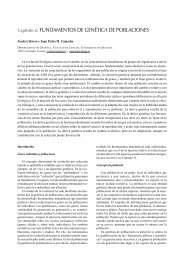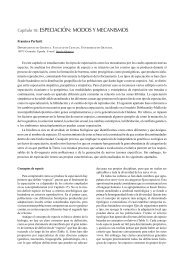Evolucion de la interacción parásito-hospedador
Evolucion de la interacción parásito-hospedador
Evolucion de la interacción parásito-hospedador
You also want an ePaper? Increase the reach of your titles
YUMPU automatically turns print PDFs into web optimized ePapers that Google loves.
○ ○ ○ ○ ○ ○ ○ ○ ○ ○ ○ ○ ○ ○ ○ ○ ○ ○ ○ ○ ○ ○ ○ ○ ○ ○ ○ ○ ○ ○ ○ ○ ○ ○ ○ ○ ○ ○ ○ ○ ○ ○ ○ ○ ○ ○ ○ ○ ○ ○ ○ ○ ○ ○ ○ ○ ○ ○ ○ ○ ○496 Santiago MerinoPRICE, P.W. 1980. Evolutionary biology of parasites. PrincetonUniversity Press, Princeton.SMITH, N.G. 1968. The advantage of being parasitized. Nature 219:690-694.SOLER, J.J., MØLLER A.P. y SOLER, M. 1998. Mafia behaviour andthe evolution of facultative virulence. J. theor. Biol. 191: 267-277.TOFT, C.A. 1991. Current theory of host-parasite interactions. En J.E.Loye y M. Zuk (eds): Bird-parasite interactions. Ecology Evolutionand behaviour. Pp: 3-18. Oxford Univ. Press, Oxford.TOFT, C.A. y KARTER, A.J. 1990. Parasite-host coevolution. TrendsEcol. Evol. 5: 326-329.VAN BAALEN, M. 1998. Coevolution of recovery ability and virulence.Proc. R. Soc. Lond. B 265: 317-325.VAN VALEN, L. 1973. A new evolutionary <strong>la</strong>w. Evolut. Theory 1: 1-30.VEIGA, J.P., SALVADOR, A., MERINO, S. y PUERTA, M. 1998.Reproductive effort affects immune response and parasite infectionin a lizard: a phenotypic manipu<strong>la</strong>tion using testosterone. Oikos82: 313-318.WEATHERHEAD, P.J. y BENNETT, G.F. 1991. Ecology of red-wingedb<strong>la</strong>ckbird parasitism by Haematozoa. Can. J. Zool. 69: 2352-2359.WILLIAMS, T.D., CHRISTIANS, J.K., AIKEN, J.J. y EVANSON, M.1999. Enhanced immune function does not <strong>de</strong>press reproductiveoutput. Proc. R. Soc. Lond. B 266: 753-757.WINDSOR, D.A. Equal rights for parasites. Conserv. Biol. 9: 1-2.Lecturas recomendadas(1) BARNARD, C.J. y BEHNKE, J.M. 1990. Parasitism and host behaviour. Taylor and Francis, Londres. En capítulos escritos porexpertos en cada tema se repasan <strong>la</strong>s distintas alteraciones que parásitos y <strong>hospedador</strong>es inducen mutuamente sobre sus comportamientos.(2) CLAYTON, D.H. y MOORE, J. 1997. Host-Parasite Evolution. General principles and avian mo<strong>de</strong>ls. Oxford Univ. Press, Oxford.Aunque centrado en mo<strong>de</strong>los aviares <strong>la</strong> mayor parte <strong>de</strong>l libro ofrece una revisión general sobre distintos aspectos <strong>de</strong> <strong>la</strong> evoluciónentre parásitos y <strong>hospedador</strong>es. Los apéndices sobre recolección, i<strong>de</strong>ntificación y cuantificación <strong>de</strong> parásitos pue<strong>de</strong>n ser útiles parael que se aproxime por primera vez al estudio <strong>de</strong> estos seres.(3) LOYE, J.E. y ZUK, M. 1991. Bird-parasite interactions. Ecology, Evolution and Behaviour. Oxford Univ. Press, Oxford. Un tomoque aporta una gran cantidad <strong>de</strong> ejemplos <strong>de</strong> estudios sobre <strong>la</strong> re<strong>la</strong>ción entre aves y sus parásitos. Organizado en secciones sobreecología, comportamiento y selección sexual.(4) POULIN, R. 1998. Evolutionary ecology of parasites: from individuals to communities. Chapman and Hall, Londres. Este libro nosofrece el estudio <strong>de</strong> <strong>la</strong> evolución entre parásito y <strong>hospedador</strong> <strong>de</strong>s<strong>de</strong> un punto <strong>de</strong> vista muchas veces olvidado; el <strong>de</strong>l parásito.(5) TOFT, C. A., AESCHLIMANN, A. y BOLIS, L. 1991. Parasite-Host Associations: Coexistence or Conflict? Oxford Univ. Press,Oxford. Este volumen revisa los conocimientos generales sobre <strong>la</strong>s re<strong>la</strong>ciones entre parásitos y <strong>hospedador</strong>es tocando gran cantidad<strong>de</strong> aspectos sobre los distintos factores que pue<strong>de</strong>n influir en dicha re<strong>la</strong>ción.


